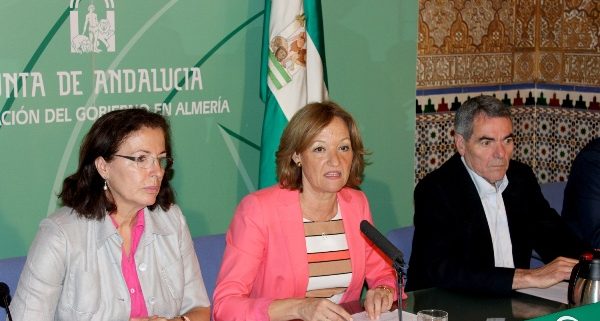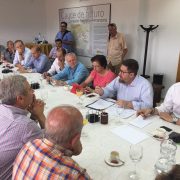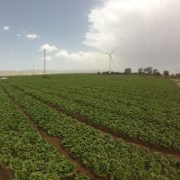The quality certifications and Biological Control, normal practices of more than 70% of horticulturists almerienses
Almost 80% of the growers in Almería has its productions certified by a seal of quality and 70% carry Biological Control, as is clear from the study “Unbreakable province of Almeria system vegetable production, as a result of the collaboration between the Institute and Fisheries Agricultural Training (IFAPA) and the Cajamar Foundation, which recently presented the Minister of Agriculture, Fisheries and Rural Development, of Andalusian Government, Carmen Ortiz.
From the above study, are detected among other issues the development of intensive agriculture in the province, “it rests on a very important tehnical support, which helps farmers in decision-making with the aim of raising the level of production and the quality of it “.
During his speech, the minister stressed the “indisputable economic and social importance” of almeriense protected horticultural sector, reflected in its contribution to GDP of the province (20%) and its production value: 2,000 million euros, representing 90% of the value of agricultural production in Almería and more than 60% of the value of the Andalusian horticultural production.
This is also, as highlighted, a sector whose importance “lies not only in its production figures and marketing, but also in its ability to induce business and create jobs”, namely, more than 50,000 direct jobs and indirect. in total, the protected horticulture of Almería gathers a network of 243 companies handling and processing, auxiliary industry and other economic sectors, suc the continuing demand exists on the part of fruit and vegetables sector from Almeria to know the characteristics of its production system and its evolution over time. The study characterizes the production system of protected horticulture by analyzing various parameters of the 2012-2013 campaign; and continues the campaigns conducted in 1999-2000 (prepared by the Foundation for Agricultural Research in the Province of Almería -Fiapa-, the University of Almeria and the Experimental Station of Cajamar Palmerillas) and 2005-2006 (by Ifapa and Cajamar).
It is therefore a thorough analysis that identifies changes in this production system over time. “They are fundamental data for both the private sector and administrations can from more objective data to make better decisions,” said Ortiz.
Spectacular growth of Biological Control
Comparison of these studies shows that the main transformation in recent years in the Almeria horticulture has occurred in the Biological Control, an area in which there has been a “radical change” as if today 70% of farmers surveyed admit to having put into practice these techniques in the 2005-2006 campaign barely made 4%. The study attributes this radical change to the phytosanitary problems of 2007, “which meant the turning point in the use of auxiliary fauna, both predators and parasitoids.”
Today, crops such as peppers have 97% of its area under biological control. The report concludes that “today, Almería is the area with the highest concentration of greenhouses in the world where the biological control technique is used as usual. The adoption of this friendly practices with the environment has been implemented with the support of all the actors who make up the horticultural production system Almería “.
Certified quality
Among the conclusions drawn from this study also finds that the pursuit of excellence and obtaining products which can compete in the best conditions in the demanding international markets, has led to the Almeria horticulturalists to worry about getting quality certifications for their productions. Thus, 78.7% of farmers in the province certify their production under a seal of quality. More than a third of them, 34.7% also has two or more certifications. The most commonly used standard is ‘Global GAP Fruit and Vegetables’ (almost 49%), followed by the ‘UNE 155001, vegetables for fresh consumption, controlled production of protected crops’ (41.2%) and Integrated Production (19, 5%).
In the presentation of this study, in addition to the minister, have participated the Ifapa president, Jerónimo Pérez, the president of the Foundation Cajamar, Jerónimo Molina, and the coordinator of Research and Transfer of this foundation, Juan Carlos Gázquez.
More training
For the writing of this study has been carried out field work consisting of 450 surveys to producers with significant holdings in different regions, specifically in Campo de Dalías and Field of Níjar-Low Andarax. This paper, prepared during 2015, analyzes both the characteristics of the Almeria horticultural during the 2012-2013 campaign, and producers (training, use of computers and counseling) and holdings.
In this regard, the study concludes that most farmers in Almeria (81.2%) received some kind of formal training and, compared to the 2005-2006 campaign a higher educational level is observed, since it has reduced the number of producers who have not completed compulsory education (33.5% then to 18.8% now). The proportion of farmers with high school or vocational training has increased in recent years from 11.5% to 20.4%. In addition to this training, there is also another specific qualifications for professionals in agriculture, for example, courses in addition to the agricultural enterprise (20,2% of farmers surveyed who have done) or applicator plant protection products (89.3% have done).
Also, an increasing number of farmers who have made other monographs and shorter courses are also observed. Thus, 38.7% of respondents have attended a training event of this type and 27.1% of them participated in a course of Biological Control.
To promote training and professionalization of farming, the Ministry has been developing, among other actions, an offer of 152 courses and 14 seminars aimed at this group, given by the Ifapa center Mojonera over the past year.
Another important finding of this report is the sharp increase experienced by communication technologies as sources of information and consultation, and especially the Internet, totaling 0.4% (according to the study 1999-2000) to 42.7 %, it is positioning itself as the most important route information behind the figure’s technical adviser. In fact, the level of expertise is very high, almost 100% of the producers use this support. Among the issues addressed are phytosanitary treatments (97% of farmers) followed by issues pests, fertilization and irrigation.
Larger greenhouses
As for the current radiograph of farms, 89% of these are in the hands of men, and the average age of owners of farms amounted to 44.3 years for men and 46.4 for women. The average area of the greenhouses totaled 6,200 square meters in the 1999-2000 season, to 7538.5 square meters in 2005-2006 and 2013-2014 8601.6 square meters. The average age of the greenhouses is 16 years. The minister recalled the commitment of the Board to take summer after a call for aid for the modernization of greenhouses which will be initially funded with a budget of 20 million euros.
The publication is completed with an opinion survey of producers where the main problems detected and improvements should be undertaken are collected. Among the challenges of these producers is the loss of farm profitability due to rising production costs and falling prices, a given circumstance in recent seasons by problems of the sector which have joined another political roots, as the Russian veto on imports of fresh fruit and vegetables from the European Union.
Source: CAPDER
















